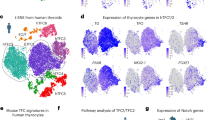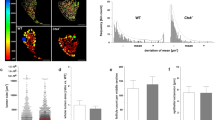Abstract
Thyroid hormones T3/T4 participate in the fine tuning of development and performance. The formation of thyroid hormones requires the accumulation of I− by the electrogenic Na+/I− symporter, which depends on the electrochemical gradient across the cell membrane and thus on K+ channel activity. The present paper explored whether Kcnq1, a widely expressed voltage-gated K+ channel, participates in the regulation of thyroid function. To this end, Kcnq1 expression was determined by RT-PCR, confocal microscopy, and thyroid function analyzed in Kcnq1 deficient mice (Kcnq1 −/−) and their wild-type littermates (Kcnq1 +/+). Moreover, Kcnq1 abundance and current were determined in the thyroid FRTL-5 cell line. Furthermore, mRNA encoding KCNQ1 and the subunits KCNE1-5 were discovered in human thyroid tissue. According to patch-clamp TSH (10 mUnits/ml) induced a voltage-gated K+ current in FRTL-5 cells, which was inhibited by the Kcnq inhibitor chromanol (10 μM). Despite a tendency of TSH plasma concentrations to be higher in Kcnq1 −/− than in Kcnq1 +/+ mice, the T3 and T4 plasma concentrations were significantly smaller in Kcnq1 −/− than in Kcnq1 +/+ mice. Moreover, body temperature was significantly lower in Kcnq1 −/− than in Kcnq1 +/+ mice. In conclusion, Kcnq1 is required for proper function of thyroid glands.





Similar content being viewed by others
References
Bachmann O, Heinzmann A, Mack A, Manns MP, Seidler U (2007) Mechanisms of secretion-associated shrinkage and volume recovery in cultured rabbit parietal cells. Am J Physiol Gastrointest Liver Physiol 292:G711–G717
Barhanin J, Lesage F, Guillemare E, Fink M, Lazdunski M, Romey G (1996) K(V)LQT1 and lsK (minK) proteins associate to form the I(Ks) cardiac potassium current. Nature 384:78–80
Boini KM, Graf D, Hennige AM, Koka S, Kempe DS, Wang K, Ackermann TF, Foller M, Vallon V, Pfeifer K, Schleicher E, Ullrich S, Haring HU, Haussinger D, Lang F (2009) Enhanced insulin sensitivity of gene-targeted mice lacking functional KCNQ1. Am J Physiol Regul Integr Comp Physiol 296:R1695–R1701
Casimiro MC, Knollmann BC, Ebert SN, Vary JC Jr, Greene AE, Franz MR, Grinberg A, Huang SP, Pfeifer K (2001) Targeted disruption of the Kcnq1 gene produces a mouse model of Jervell and Lange-Nielsen Syndrome. Proc Natl Acad Sci USA 98:2526–2531
Dai G, Levy O, Carrasco N (1996) Cloning and characterization of the thyroid iodide transporter. Nature 379:458–460
Das B, Heimeier RA, Buchholz DR, Shi YB (2009) Identification of direct thyroid hormone response genes reveals the earliest gene regulation programs during frog metamorphosis. J Biol Chem 284:34167–34178
Dedek K, Waldegger S (2001) Colocalization of KCNQ1/KCNE channel subunits in the mouse gastrointestinal tract. Pfluegers Arch 442:896–902
Demolombe S, Franco D, de Boer P, Kuperschmidt S, Roden D, Pereon Y, Jarry A, Moorman AF, Escande D (2001) Differential expression of KvLQT1 and its regulator IsK in mouse epithelia. Am J Physiol Cell Physiol 280:C359–C372
Dremier S, Coulonval K, Perpete S, Vandeput F, Fortemaison N, Van Keymeulen A, Deleu S, Ledent C, Clement S, Schurmans S, Dumont JE, Lamy F, Roger PP, Maenhaut C (2002) The role of cyclic AMP and its effect on protein kinase A in the mitogenic action of thyrotropin on the thyroid cell. Ann NY Acad Sci 968:106–121
Finsterer J, Stollberger C (2004) Skeletal muscle involvement in congenital long QT syndrome. Neurol Sci 25:238–240
Grahammer F, Herling AW, Lang HJ, Schmitt-Graff A, Wittekindt OH, Nitschke R, Bleich M, Barhanin J, Warth R (2001) The cardiac K+ channel KCNQ1 is essential for gastric acid secretion. Gastroenterology 120:1363–1371
Grunnet M, Jespersen T, MacAulay N, Jorgensen NK, Schmitt N, Pongs O, Olesen SP, Klaerke DA (2003) KCNQ1 channels sense small changes in cell volume. J Physiol 549:419–427
Hamill OP, Marty A, Neher E, Sakmann B, Sigworth FJ (1981) Improved patch-clamp techniques for high-resolution current recording from cells and cell-free membrane patches. Pflugers Arch 391:85–100
Heitzmann D, Grahammer F, von Hahn T, Schmitt-Graff A, Romeo E, Nitschke R, Gerlach U, Lang HJ, Verrey F, Barhanin J, Warth R (2004) Heteromeric KCNE2/KCNQ1 potassium channels in the luminal membrane of gastric parietal cells. J Physiol 561:547–557
Jensen MV, Joseph JW, Ronnebaum SM, Burgess SC, Sherry AD, Newgard CB (2008) Metabolic cycling in control of glucose-stimulated insulin secretion. Am J Physiol Endocrinol Metab 295:E1287–E1297
Kunz L, Roggors C, Mayerhofer A (2007) Ovarian acetylcholine and ovarian KCNQ channels: insights into cellular regulatory systems of steroidogenic granulosa cells. Life Sci 80:2195–2198
Kunzelmann K (2005) Ion channels and cancer. J Membr Biol 205:159–173
Kuwamura M, Okajima R, Yamate J, Kotani T, Kuramoto T, Serikawa T (2008) Pancreatic metaplasia in the gastro-achlorhydria in WTC-dfk rat, a potassium channel Kcnq1 mutant. Vet Pathol 45:586–591
Ladenson PW, Singer PA, Ain KB, Bagchi N, Bigos ST, Levy EG, Smith SA, Daniels GH, Cohen HD (2000) American thyroid association guidelines for detection of thyroid dysfunction. Arch Intern Med 160:1573–1575
Lan WZ, Abbas H, Lemay AM, Briggs MM, Hill CE (2005) Electrophysiological and molecular identification of hepatocellular volume-activated K + channels. Biochim Biophys Acta 1668:223–233
Lan WZ, Wang PY, Hill CE (2006) Modulation of hepatocellular swelling-activated K + currents by phosphoinositide pathway-dependent protein kinase C. Am J Physiol Cell Physiol 291:C93–C103
Lang F, Foller M, Lang KS, Lang PA, Ritter M, Gulbins E, Vereninov A, Huber SM (2005) Ion channels in cell proliferation and apoptotic cell death. J Membr Biol 205:147–157
Lee MP, Ravenel JD, Hu RJ, Lustig LR, Tomaselli G, Berger RD, Brandenburg SA, Litzi TJ, Bunton TE, Limb C, Francis H, Gorelikow M, Gu H, Washington K, Argani P, Goldenring JR, Coffey RJ, Feinberg AP (2000) Targeted disruption of the Kvlqt1 gene causes deafness and gastric hyperplasia in mice. J Clin Invest 106:1447–1455
Morokuma J, Blackiston D, Adams DS, Seebohm G, Trimmer B, Levin M (2008) Modulation of potassium channel function confers a hyperproliferative invasive phenotype on embryonic stem cells. Proc Natl Acad Sci USA 105:16608–16613
Neyroud N, Tesson F, Denjoy I, Leibovici M, Donger C, Barhanin J, Faure S, Gary F, Coumel P, Petit C, Schwartz K, Guicheney P (1997) A novel mutation in the potassium channel gene KVLQT1 causes the Jervell and Lange-Nielsen cardioauditory syndrome. Nat Genet 15:186–189
Nicolas M, Dememes D, Martin A, Kupershmidt S, Barhanin J (2001) KCNQ1/KCNE1 potassium channels in mammalian vestibular dark cells. Hear Res 153:132–145
Pfaffl MW (2001) A new mathematical model for relative quantification in real-time RT-PCR. Nucleic Acids Res 29:e45
Roepke TK, King EC, Reyna-Neyra A, Paroder M, Purtell K, Koba W, Fine E, Lerner DJ, Carrasco N, Abbott GW (2009) Kcne2 deletion uncovers its crucial role in thyroid hormone biosynthesis. Nat Med 15:1186–1194
Roura-Ferrer M, Sole L, Martinez-Marmol R, Villalonga N, Felipe A (2008) Skeletal muscle Kv7 (KCNQ) channels in myoblast differentiation and proliferation. Biochem Biophys Res Commun 369:1094–1097
Sanguinetti MC, Curran ME, Zou A, Shen J, Spector PS, Atkinson DL, Keating MT (1996) Coassembly of K(V)LQT1 and minK (IsK) proteins to form cardiac I(Ks) potassium channel. Nature 384:80–83
Sarzani R, Pietrucci F, Francioni M, Salvi F, Letizia C, D'Erasmo E, Dessi FP, Rappelli A (2006) Expression of potassium channel isoforms mRNA in normal human adrenals and aldosterone-secreting adenomas. J Endocrinol Investig 29:147–153
Scarff KL, Judd LM, Toh BH, Gleeson PA, Van Driel IR (1999) Gastric H(+), K(+)-adenosine triphosphatase beta subunit is required for normal function, development, and membrane structure of mouse parietal cells. Gastroenterology 117:605–618
Schroeder BC, Waldegger S, Fehr S, Bleich M, Warth R, Greger R, Jentsch TJ (2000) A constitutively open potassium channel formed by KCNQ1 and KCNE3. Nature 403:196–199
Shojaie M, Eshraghian A (2008) Primary hypothyroidism presenting with Torsades de pointes type tachycardia: a case report. Cases J 1:298
Sugimoto T, Tanabe Y, Shigemoto R, Iwai M, Takumi T, Ohkubo H, Nakanishi S (1990) Immunohistochemical study of a rat membrane protein which induces a selective potassium permeation: its localization in the apical membrane portion of epithelial cells. J Membr Biol 113:39–47
Trinh NT, Prive A, Kheir L, Bourret JC, Hijazi T, Amraei MG, Noel J, Brochiero E (2007) Involvement of KATP and KvLQT1 K + channels in EGF-stimulated alveolar epithelial cell repair processes. Am J Physiol Lung Cell Mol Physiol 293:L870–L882
Tsevi I, Vicente R, Grande M, Lopez-Iglesias C, Figueras A, Capella G, Condom E, Felipe A (2005) KCNQ1/KCNE1 channels during germ-cell differentiation in the rat: expression associated with testis pathologies. J Cell Physiol 202:400–410
Unoki H, Takahashi A, Kawaguchi T, Hara K, Horikoshi M, Andersen G, Ng DP, Holmkvist J, Borch-Johnsen K, Jorgensen T, Sandbaek A, Lauritzen T, Hansen T, Nurbaya S, Tsunoda T, Kubo M, Babazono T, Hirose H, Hayashi M, Iwamoto Y, Kashiwagi A, Kaku K, Kawamori R, Tai ES, Pedersen O, Kamatani N, Kadowaki T, Kikkawa R, Nakamura Y, Maeda S (2008) SNPs in KCNQ1 are associated with susceptibility to type 2 diabetes in East Asian and European populations. Nat Genet 40:1098–1102
Vallon V, Grahammer F, Richter K, Bleich M, Lang F, Barhanin J, Volkl H, Warth R (2001) Role of KCNE1-dependent K+ fluxes in mouse proximal tubule. J Am Soc Nephrol 12:2003–2011
Vallon V, Grahammer F, Volkl H, Sandu CD, Richter K, Rexhepaj R, Gerlach U, Rong Q, Pfeifer K, Lang F (2005) KCNQ1-dependent transport in renal and gastrointestinal epithelia. Proc Natl Acad Sci USA 102:17864–17869
van Tol BL, Missan S, Crack J, Moser S, Baldridge WH, Linsdell P, Cowley EA (2007) Contribution of KCNQ1 to the regulatory volume decrease in the human mammary epithelial cell line MCF-7. Am J Physiol Cell Physiol 293:C1010–C1019
Wangemann P (2006) Supporting sensory transduction: cochlear fluid homeostasis and the endocochlear potential. J Physiol 576:11–21
Yasuda K, Miyake K, Horikawa Y, Hara K, Osawa H, Furuta H, Hirota Y, Mori H, Jonsson A, Sato Y, Yamagata K, Hinokio Y, Wang HY, Tanahashi T, Nakamura N, Oka Y, Iwasaki N, Iwamoto Y, Yamada Y, Seino Y, Maegawa H, Kashiwagi A, Takeda J, Maeda E, Shin HD, Cho YM, Park KS, Lee HK, Ng MC, Ma RC, So WY, Chan JC, Lyssenko V, Tuomi T, Nilsson P, Groop L, Kamatani N, Sekine A, Nakamura Y, Yamamoto K, Yoshida T, Tokunaga K, Itakura M, Makino H, Nanjo K, Kadowaki T, Kasuga M (2008) Variants in KCNQ1 are associated with susceptibility to type 2 diabetes mellitus. Nat Genet 40:1092–1097
Acknowledgements
The authors acknowledge the technical assistance of E. Faber, R. Engelhardt, B. Rausch, and Dr. B. Riederer for breeding and genotyping kcnq1 −/− and kcnq1 +/+ mice. The manuscript was meticulously prepared by T. Loch and L. Subasic. This study was supported by the Deutsche Forschungsgemeinschaft (GK 1302) and Se460/9-6 (to U.S.).
Author information
Authors and Affiliations
Corresponding author
Additional information
Henning Fröhlich, Krishna M. Boini, and Guiscard Seebohm contributed equally and thus share first authorship.
Rights and permissions
About this article
Cite this article
Fröhlich, H., Boini, K.M., Seebohm, G. et al. Hypothyroidism of gene-targeted mice lacking Kcnq1. Pflugers Arch - Eur J Physiol 461, 45–52 (2011). https://doi.org/10.1007/s00424-010-0890-5
Received:
Revised:
Accepted:
Published:
Issue Date:
DOI: https://doi.org/10.1007/s00424-010-0890-5




